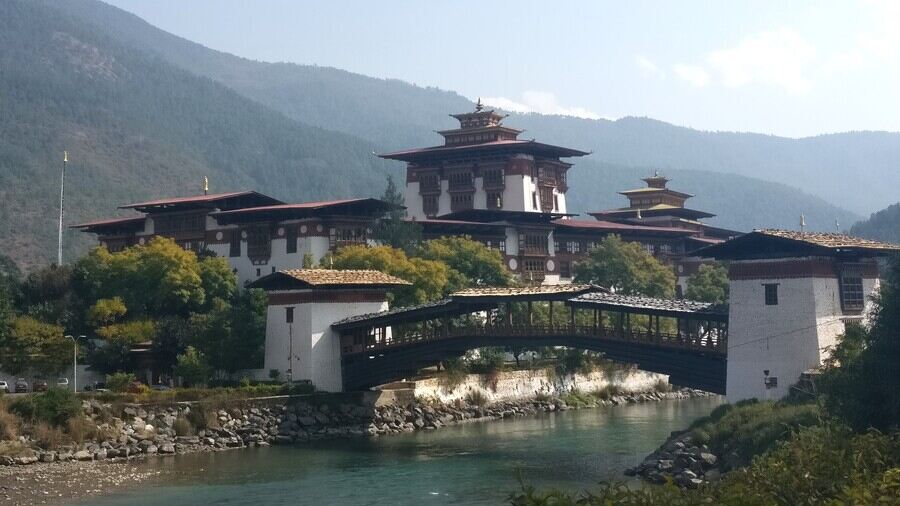Our first meal in Thimpu, the capital of the Himalayan kingdom of Bhutan, was a memorable one at the luxurious Six Senses Thimpu, also known as the ‘Palace in the Sky’. Situated high up on a mountain and surrounded by apple orchards and pine forests, the hotel offers breathtaking views of the valley below through floor-to-ceiling windows. The meal featured a special 48-hour sourdough bread with knobbly Phobjikha potatoes in cheese, Hogay cucumber salad — slices of cucumber with local chillies and spices — a delightful red rice cold salad, and vegetable fried rice.
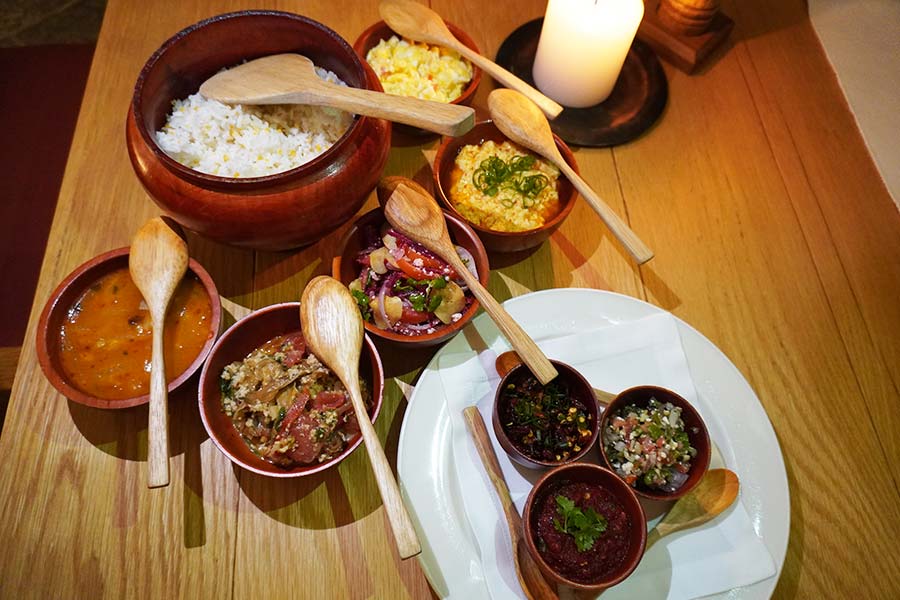
A Bhutanese meal of rice, scrambled egg, three kinds of chilli preserves, lentils and salad Kalpana Sunder
Bhutan, the landlocked country in the Eastern Himalayas between India and Tibet, has different ethnic groups and its rich tapestry of food is influenced by the altitude, geography and local culture, as well as influences from its neighbouring countries like India, Nepal and Tibet.
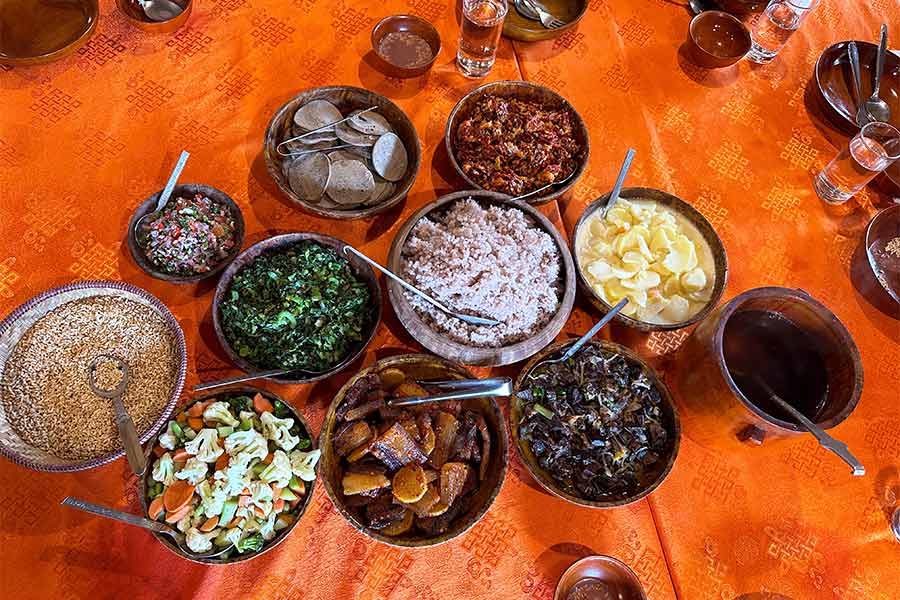
Traditional Bhutanese cuisine served at a local restaurant Shutterstock
Most Bhutanese dishes are eaten with red rice, called Gondomar, as well as buckwheat or maize. Due to the cold weather, much of Bhutanese cuisine is comforting, featuring warm soups or stews known as Jaju, made with meat, vegetables, ferns, cheese, butter and lentils. Very often they have turnip leaves, which are harvested, sun-dried, and stored for use in winter. Fiddlehead ferns and foraged greens are a part of the diet, too. With many inhabitants of the region descending from Tibetans, this influence can also be seen in the food of the western regions. Tibetan noodles, such as thukpa, and snacks such as momo dumplings can be found on local menus.

(L-R) Bhutanese eat a lot of chillies. Apparently, it helps them combat the cold weather; fiddlehead ferns and foraged greens figure on many Bhutanese menus and fresh local produce makes Bhutanese food delicious Kalpana Sunder
“Just as Bhutan is dedicated to preserving traditional clothing like the gho and kira, worn by men and women, it is also committed to preserving its culinary heritage,” explained our local guide, Sithup. They pass down ancestral knowledge and techniques from one generation to the next. Traditional cooking methods, such as using open fires and clay pots, are still practised in many households, especially in rural Bhutan.
Southern Bhutan is home to the Bhutanese of Nepali descent. The traditional food of this region is influenced by Indian and Nepali cuisine. Rice and roti are eaten with lentil stews, spicy curries and pickles. Zow Shungo, another one of the popular dishes of Bhutan, is testimony to the sustainable approach of the Bhutanese. This is a dish usually made from leftovers of vegetables and red rice with garlic, ginger and spices added. “Last night’s dinner was converted into today’s breakfast,” said Sithup. Nakey, a popular street food that is made with puffed rice, peanut, and spices is found almost everywhere.
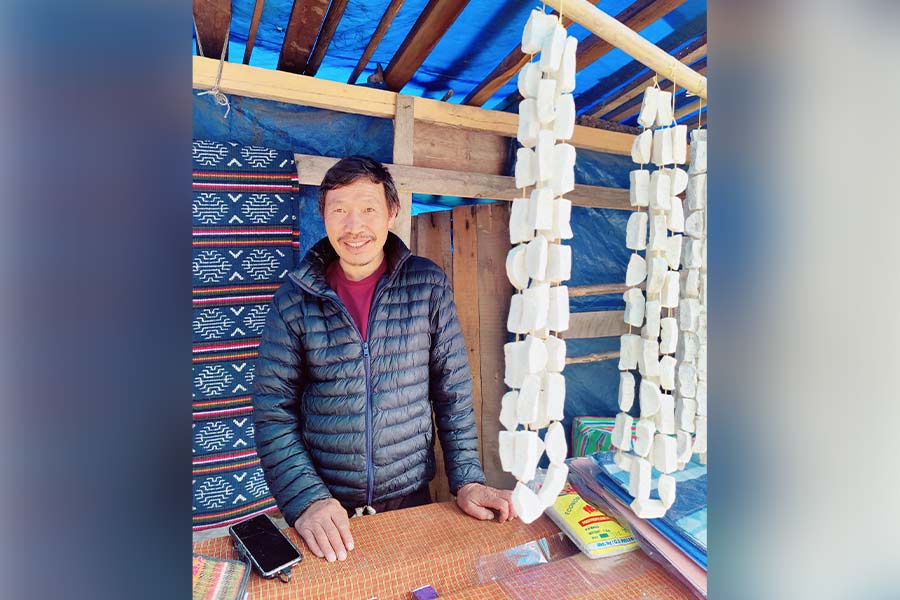
Chugo or Chhurpi is the hard yak's cheese that is sold like garlands around Bhutan Kalpana Sunder
A staple of Bhutanese food is red rice, grown at high altitudes and known for its nutty flavour. Dairy is another cornerstone of Bhutanese cuisine — butter and cheese are staples, made from cow, sheep or yak’s milk. Cheese made from cow’s milk is often used to make sauces. Hard yak’s cheese, called Chhurpi, hangs in stalls like garlands, and chewing it is a task in itself.
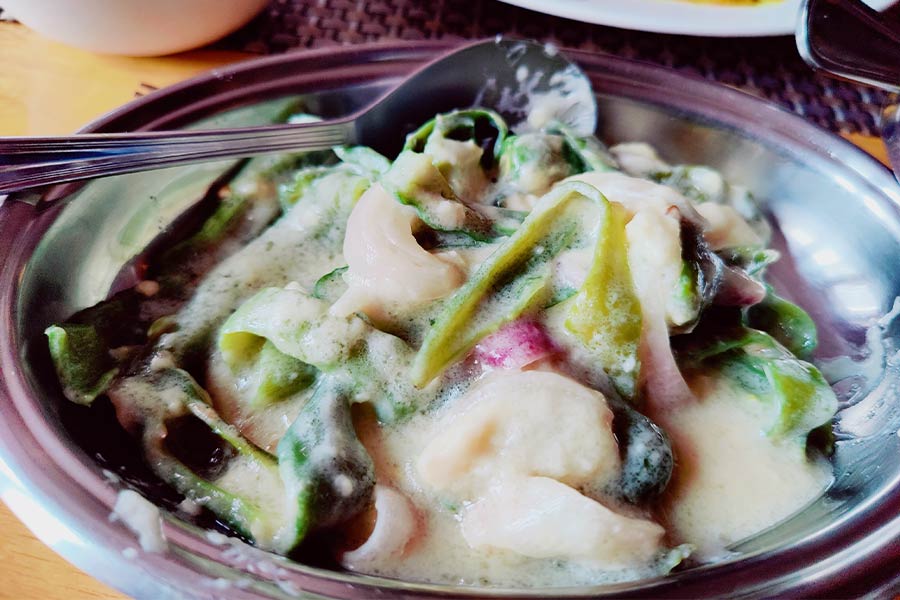
Ema Datshi is the signature dish of Bhutan and many local variations exist of this cheese and chillies dish Kalpana Sunder
Meat eaters have a lot on their plates, from yak meat to chicken, beef, and pork, as well as a variety of dried meat dishes. Chillies are not just additions to a dish, very often, they are the main ingredients. Ema Datshi is the signature dish of the country — a traditional Bhutanese stew prepared using hot chilli peppers and cheese (made from cow or yak milk), mixed with garlic, water and oil. I taste variations of the dish, from creamy to broth-like, including the use of green chilli, red chilli or organic sun-dried white chilli, with some people adding tomatoes, garlic onion, and spring onions or leeks as I travel from Thimpu to the east, to Gangtey, Trongsa, and finally Bumthang and Paro.
In the beautiful north-central valley of Bumthang, considered the spiritual heartland of the country, buckwheat is the star, as it grows easily here. The region is also known for its dairy — Swiss cheese, started by a Swiss cheesemaker in the Sixties, butter and curd.

Local cheese with chilli that is a accompaniment to every meal Kalpana Sunder
At Amankora, Bumthang, in the district capital of Jakar, at a 16-suite lodge, chef Tshering Phuntsho, a fit cyclist and runner who comes from Mongar in eastern Bhutan, said many of the dishes he served were inspired by those made in his mother’s kitchen. He served us a full rustic Bhutanese dinner, starting with a creamy roasted wheat flour soup with coriander, followed by Datshi Makhu — local farmer’s cheese with ginger, garlic, sun-dried red chilli powder and Bumthang butter. A piquant mountain radish and local peppercorn curry with garlic and ginger followed. I found it interesting that we were served a local rice mixed with polenta called Sharchop Kharang. I also loved his spicy version of Ema Datshi, made with whole sun-dried white chilies and yak cheese.
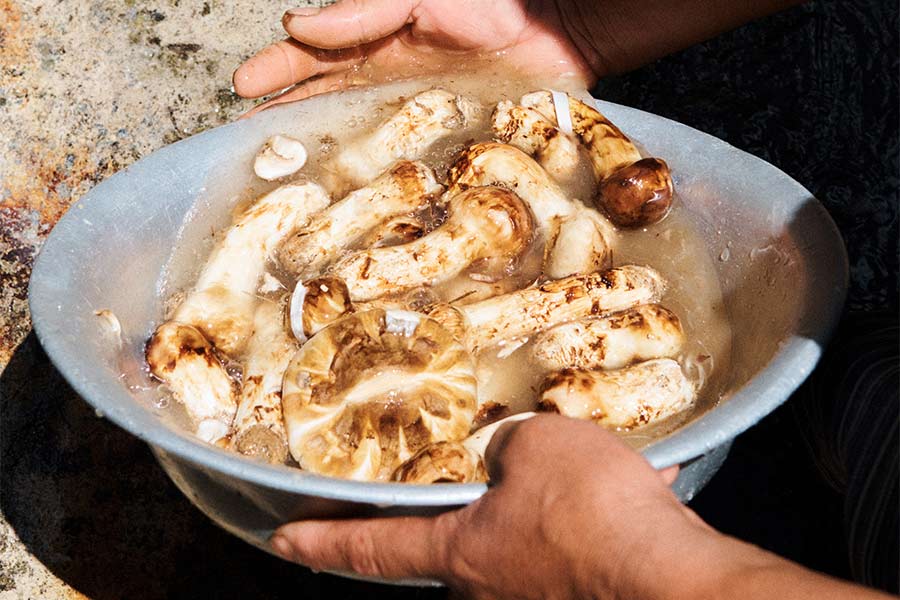
Mushrooms are an integral part of Bhutanese food Kalpana Sunder
Another staple, especially for vegetarians in Bhutan, is mushrooms. Gondo Datshi is a delicious local dish that combines mushrooms and cheese in a flavorful sauce. Jilli Namcho (wood ear mushrooms) is one of the many mushroom dishes popular in rural areas. There are also chanterelles, matsutake, and more, especially during mushroom season in late summer. We heard about the annual Matsutake Mushroom Festival in Bumthang’s Ura Valley, held in August, celebrating this highly sought-after mushroom, which is in demand in countries like Japan and grows at altitudes above 9,800 feet. Over three days, visitors taste, watch and participate in mushroom picking.
Most meals are accompanied by strong and fiery Ara, a traditional Bhutanese alcoholic drink, prepared by fermenting or distilling rice, wheat, maize, millet, barley or buckwheat that is poured from beautiful wooden containers called Palang, adorned with brass decorations. Tea is the usual beverage that locals like, especially the salty Suja — a churned tea made from yak butter and salt. Ngaja, a sweet milk tea similar to that found in India, is also common.
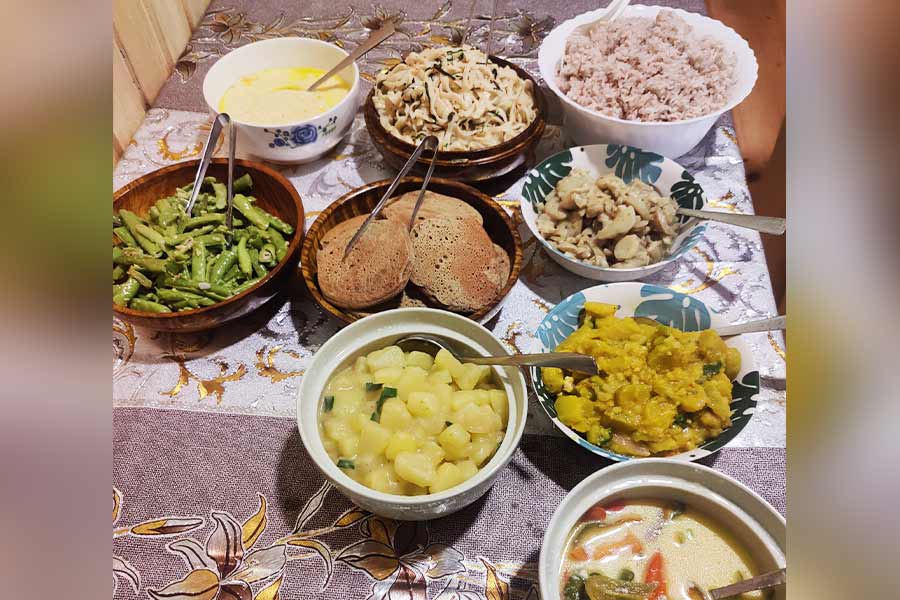
The rustic Bhutanese meal at the Tamshing Farmhouse in Bumthang Kalpana Sunder
Another special home-cooked meal we enjoyed was at the rambling Tamshing Farmhouse in Bumthang, where a mother-daughter duo cooked meals and guests could interact with them and have a simple lunch. This not only empowers the women, but also gives visitors a chance to engage with local people. I watched the matriarch stir a cheesy Ema Datshi in the large kitchen, with vessels displayed on shelves, while her daughter stirred local cow's cheese with chillies over the fire. We were served a hearty lunch that had red rice, buckwheat pancakes, a creamy pumpkin curry, fried cheese, sautéed green beans and Jambuley or Jangbuly flat noodles sprinkled with coriander leaves, onions, chilies and peppercorns — all accompanied by a shot of home-brewed Ara.

Ara, the local alcohol poured from a beautiful wooden container Bhutan Tourism
Our best food experience in Bhutan was curated by Amankora Gangtey in the Phobjikha Valley, known for its potatoes and black-necked cranes that migrate here from Tibet in winter. The meal took place in an old stone-built potato shed belonging to a local farmer, with 108 flickering candles arranged on small stones along the walls and a musician playing the Bhutanese guitar in the background.
We were served a well-orchestrated, course-by-course bucolic Bhutanese dinner paired with wine. The meal began with a delicious riverweed and egg soup called Jaju, followed by cabbage and cheese dumplings, Dolom Ngo Ngo — sautéed eggplant with onion and tomato, potato with glass noodle curry, and a delightful Shamu Ema Kam Datse featuring chanterelle mushrooms with dry red chilli and local farmer’s cheese, along with local red rice. The fresh, organic flavours coupled with the ambiance made us feel transported to rustic Bhutan, centuries ago.

Buckwheat pancakes and potato with cheese for breakfast at Aman Bumthang Kalpana Sunder
On my last day in Bhutan, I was delighted to find comfort food on the menu at the Le Méridien Paro, Riverfront, which offered beautiful views of the river from its windows. From Kewa Datshi (potato with cheese and chilli) and buckwheat pancakes to a delicious Bhutanese fire-roasted pumpkin soup with chilli oil, I found happiness on my plate.


